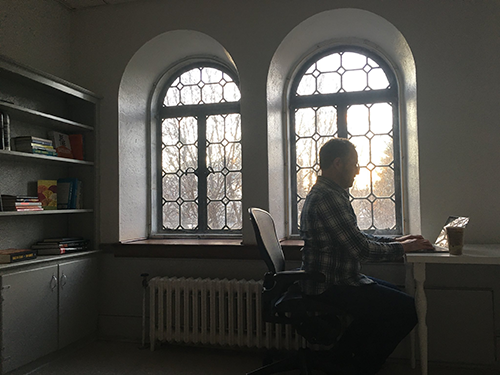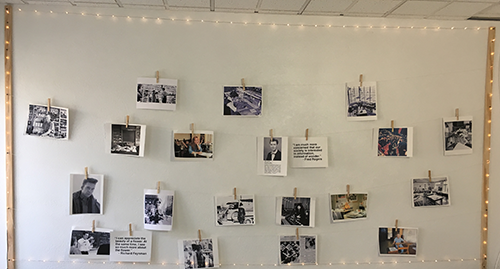I have spent years teaching about marketing, branding, blogging, social media, podcasting, speaking, ecourses, newsletters, websites, digital downloads, videos, and so much more. But I’m going to say it:
Creating is the best marketing. Period.
Meaning: doing more of your craft, publishing it and sharing it is the best way to develop an audience. That is what I am obsessing about in 2018. How can I create more. How can I encourage my clients and members of my mastermind to create more. How can I provide you more resources for you to create, and then use that as the foundation for powerful marketing.
I mean, look at the “books” pages of authors such as Joanna Penn, Jonathan Maberry, or Chuck Wendig. Their output is consistent, and a little bit astonishing.
For visual art, look at the Instagram feeds of Debbie Ridpath Ohi, or Lori Richmond, or Elise Blaha Cripe. It is filled with the creation of new art. Some are big projects, others side projects, and some mere experiments.
For each of these people, they have focused on craft first, and connected it quickly to publishing and sharing. And it reminds me of a video from illustrator Jake Parker that resonated with me called “You Need a Product Not a Project”:
There is so much wisdom in the video, including this nugget: “The world desperately needs people who finish things.” In other words: your writing and art can’t change people’s lives if you don’t finish and share it.
For myself, this year is about focusing on creation first, with two big goals:
- Publishing more books. Yes, I write every day, but I have only published one book. That changes this year. I am now writing for much longer each day, 7 days a week, and feel a clear drive towards finishing instead of just crafting.
- Learning to play guitar properly. I have dabbled with the guitar for more than 20 years, but this is the year that I will finally master that craft. Much like writing, I am practicing every day, often multiple times per day. I am following the guide of JustinGuitar.com (wonderful resources that one of my Mastermind members turned me on to!)
I am a much better writer than guitar player, yet I have found that my guitar practice is already teaching me to be a better writer. I am reminded of the fundamentals of how to improve my craft and stay focused. What I am discovering is:
- I can optimize my days to fit in little “extra” moments to work on my craft. For the guitar this is may be a few moments of practice a chord change that I have trouble with. Just 5 minutes of rote practice. For my writing, I may flesh out an idea, or do a tiny bit of research.
- I need to be ready to create anywhere. For guitar that means I now have a guitar at my home office and one in my studio. I practice on an electric guitar that isn’t plugged in, so there is no noise to bother my family or neighbors. For writing, this means getting better at idea capture — via my phone, voice recorder, or small notebook.
- I need to stay accountable. I have someone on my team whose job it is to switch between the the role of Nurse Ratched and Mr. Rogers: to give me clear and firm accountability at times, and validating support at others.
- I have become more aware that my attention is a currency that I have to spend wisely. Picking up the guitar again, I got excited to produce some full songs, so I ordered an amazing keyboard (the Korg Minilogue) for an very low price on eBay. Going to sleep that night, I realized something: every single moment I spend on that keyboard is a moment I am not practicing the guitar. I messaged the seller the next morning asking if I could cancel the order. My attention is a choice, and every “great deal” on a new piece of audio gear steals my attention from my craft.
- I have been surprised that one creative habit reinforces the others. The more I play guitar, the more I want to write. The more I write, the more I want to play guitar. This is a massive creative shift in terms of my mindset and enthusiasm each day for creation: it feels accessible, compelling, and like the obvious choice when I have a moment of downtime.
- Many (most) writers and artists I talk to experience some form of doubt or imposter syndrome in their lives. When you create every day, I find that these voices are more muffled — because it is more difficult to doubt your work when you see progress on a week-to-week basis.
I know that many of you look to me for tutorials and resources on marketing, so I will be working hard to provide that this year as well. Always feel free to email me and let me know the topics you most want to see me cover.
I also want to share with you a few amazing resources for writers focused on improving your craft and ability to publish. All of them involve my good friend Jennie Nash. She is a book coach, but she’s also a genius when it comes to writing, editing and books. She is the one who helped me when I was writing Be the Gateway, and she and I chat all the time about what it means to create great work, and best serve your audience.
She is offering three courses through Creative Live:
- How To Land A Literary Agent
- Self Publishing For the Entrepreneur
- Take Your Writing From Good To Great
If one of these topics interests you, then show up for the live event!
When I worked with Jennie, I was amazed at the clarity she provided, helping me hone in on exactly the book I wanted to write, and then structuring the process in a way that felt completely approachable.
Creating is the foundation for sharing your work, growing your audience, and truly changing people’s lives with your writing or art. Make this the year where you create every day.
Thanks.
-Dan


